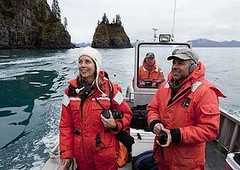由科學家、藝術家及教育家組成的海洋垃圾渦流長征國際隊伍,7日在阿拉斯加席沃(Seward)啟程。成員之一的Carl Safina表示,「召喚我們航向原始海岸的竟是因為垃圾和碎片,真是感傷。」
Safina博士和其他人加入了「渦流計畫」(Project Gyre),這項計畫旨在探索北太平洋環流上的海洋垃圾及展示海洋垃圾藝術作品,由安克拉治博物館與席沃的阿拉斯加海洋生物中心(一民間非營利海洋科學機構)共同合作。
由於海洋垃圾影響了阿拉斯加南部海岸,該團隊搭乘研究船R/V諾斯曼研究號(R/V Norseman)7日由席沃起航,將研究全球海洋垃圾危機。
從復活灣沿著基奈半島海岸往西450海哩,他們將會通過肯尼迪入口海峽到舒亞克島及阿弗格尼克島。計畫成員包括史密森尼學會、美國海洋暨大氣總署、國家地理雜誌、阿拉斯加海洋管理基金會、安克拉治博物館及美國海洋保育協會的代表。
 阿拉斯加海洋生物中心的Howard Ferren是這趟1000英里長征的主持人。而這趟長征的首席科學家Safina博士是紐約州立大學石溪分校新聞部門的教授,同時也是藍色海洋研究所的創始校長及PBS「拯救大海」系列節目主持人。
阿拉斯加海洋生物中心的Howard Ferren是這趟1000英里長征的主持人。而這趟長征的首席科學家Safina博士是紐約州立大學石溪分校新聞部門的教授,同時也是藍色海洋研究所的創始校長及PBS「拯救大海」系列節目主持人。
「我非常期待和全球最棒的一群人共同展開這趟旅程到這些地球上最棒的地方。這是我的榮幸。」Safina表示,「但令人遺憾的是我們航向這片無人造訪的海岸的原因卻是因為垃圾和碎片,這麼大堆的垃圾是新的警訊。」
每個參與計畫的人都非常興奮,國家地理2103年秋天將會將這次航行製作成節目,成員之一的藝術家Pam Longobardi會將過程放上她的部落格。
在途中這個小組會將注意力集中於海岸的垃圾,而他們已經發現了很多垃圾。在阿拉斯加的海岸線,Longobardi已經發現很多保麗龍球及許多運動球類-足球,籃球和排球,數量遠超過其他類型垃圾。他在部落格內寫道,「無論塑膠垃圾的體積多龐大,我沒辦法不撿拾及帶走(一些垃圾)就離開一個海灘。雖然個人力量能移除的不過是杯水車薪,但我們多撿一片就會減少一片在鳥或海龜的胃裡、或裂解成更細微的塑膠碎片。」「我特別注意黑色的塑膠:它更能象徵被塑膠黑化的自然環境。我正構思一件作品:巨大的黑底上噴湧出五彩繽紛、華而不實的浮標、漁網及其他產物。」
安克拉治博物館正規劃高達7500平方英尺的展示空間以展示渦流藝術作品與科學展示,預定於2014年2月開展。之後,渦流展品將由史密森尼學會重新包裝後在美國本土展出。
在藍色海洋研究所製作的影片中,Safina表示「整個計畫是不尋常的。我們不止身處於不尋常的時代、我們也在一個前所未有的時代。這個問題在一個世代前並不存在,而在地球史上也不曾出現過。」
整個計畫將以阿拉斯加的凱邁國家公園哈羅灣的密集清理為終點,該區地處偏遠,且受到2011年3月日本海嘯垃圾衝擊。
"How sad it is that garbage and debris are what is calling us to wild shores," Carl Safina said as he joined an international team of scientists, artists and educators in Seward on Friday.
Dr. Safina and the others are taking part in Project Gyre, a marine debris expedition and exhibition of marine debris art from the giant rotating ocean current that is the North Pacific Gyre.
The project is a collaboration between the Anchorage Museum and the Alaska SeaLife Center in Seward, a private, non-profit marine science facility.
The team sailed out of Seward on June 7, aboard the research vessel R/V Norseman to study the global marine debris crisis as it affects the southwest Alaska coast.
Headed 450 nautical miles west from Resurrection Bay along the Kenai Peninsula coast, they will cross the Kennedy Entrance channel to Shuyak and Afognak islands.
The expedition includes representatives from the Smithsonian Institution, National Oceanic and Atmospheric Administration, National Geographic, Alaska Marine Stewardship Foundation, Anchorage Museum and Ocean Conservancy.
Howard Ferren of the Alaska SeaLife Center is heading the 1,000 mile long expedition.
The expedition's lead scientist, Dr. Safina, is a professor in the Journalism Program at Stony Brook University in New York, the founding president of Blue Ocean Institute and host of the PBS series "Saving the Ocean."
"I am hugely looking forward to a trip-of-a-lifetime to some of the planet's best remaining places with some of the planet's most committed people. It's such an honor," said Safina. "On the other hand, how sad it is that garbage and debris are what is calling us to wild shores, that massive windrows of trash are the new sirens."
Everyone is excited – National Geographic will be doing a feature on the expedition this fall, artist and expedition member Pam Longobardi blogged on Sunday. [Link to her blog: http://driftersproject.net/2013/06/gyre-expedition-updates-and-gallery/]
As they go the team will focus their attention on shoreline trash, and they're finding plenty of that. Longobardi has seen more styrofoam balls and sponge-foam miniature sports balls – soccer, basketball and volleyballs – than any other type of trash on Alaska beaches.
"No matter how overwhelming the sheer volume of plastic is, I can't leave a beach without collecting and carrying out as much of it as I physically can," blogged Longobardi. "What one person can remove is just a drop in the ocean, but every piece we take is one less piece that will end up in a bird, a turtle or smashed to smithereens of microplastic."
"I am particularly interested in the black plastic: it more symbolically represents the dark nature of plastic," she wrote. "I am imagining an artwork that juxtaposes a giant black form spewing forth the multicolored eye-candy of floats, nets, products."
Phase two of the Gyre project culminates in a 7,500-square-foot "Gyre" art and science exhibition on view at the Anchorage Museum, scheduled for February 2014.
Following its Anchorage debut, the "Gyre" exhibition will be repackaged by the Smithsonian Institution for a tour of the continental U.S.
"The whole project is unusual," said Safina on a video made by Blue Ocean Institute. "We're not only in unusual times, we're in unprecedented times. A generation ago this problem didn't exist and had never existed before in the history of the planet."
The Gyre expedition will end with an intensive cleanup of Hallo Bay in Alaska's Katmai National Park, a remote area that has experienced an influx of debris from the March 2011 Japanese tsunami.
※ 全文及圖片詳見:ENS


